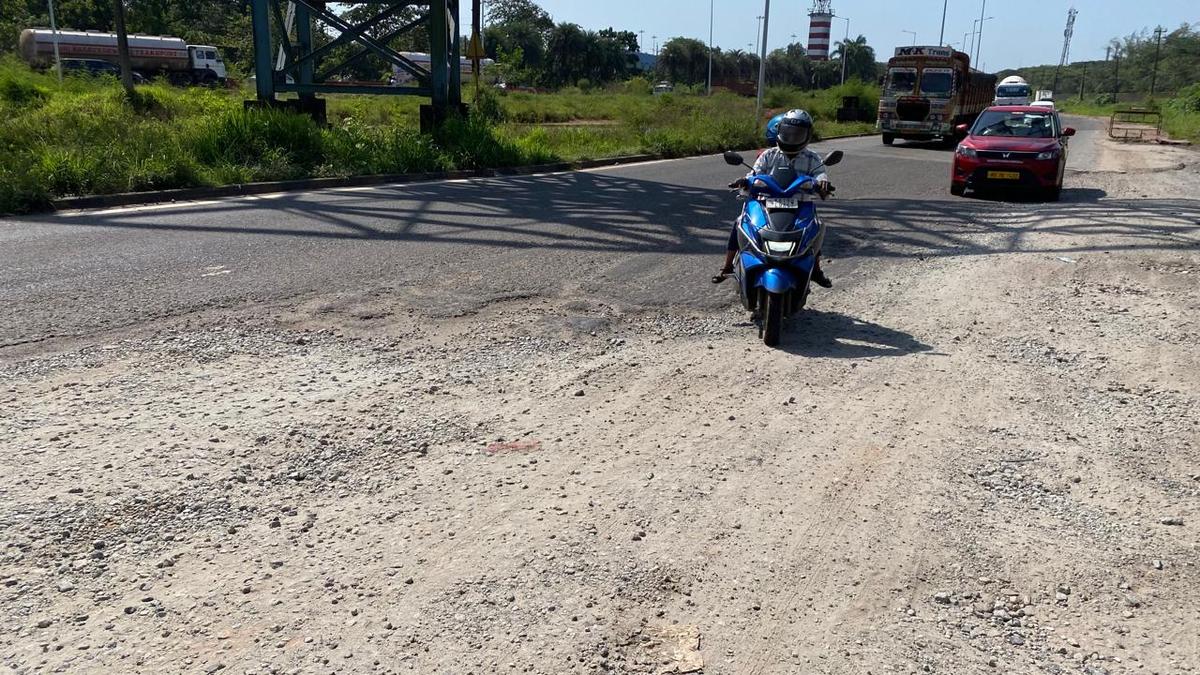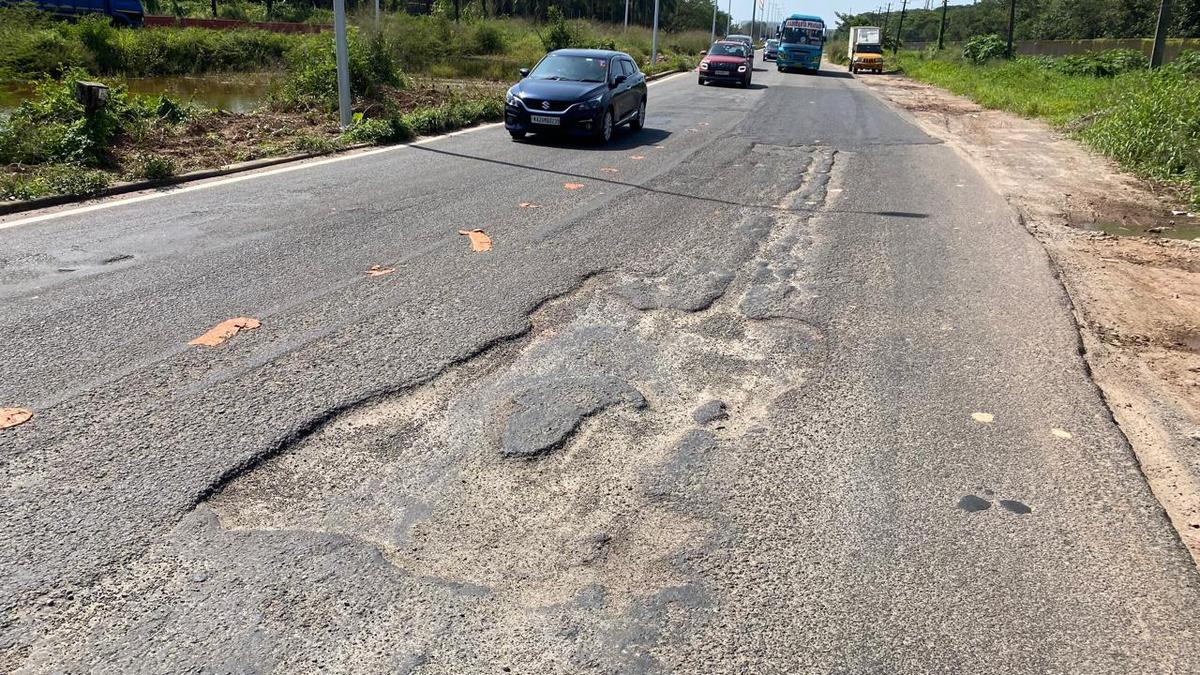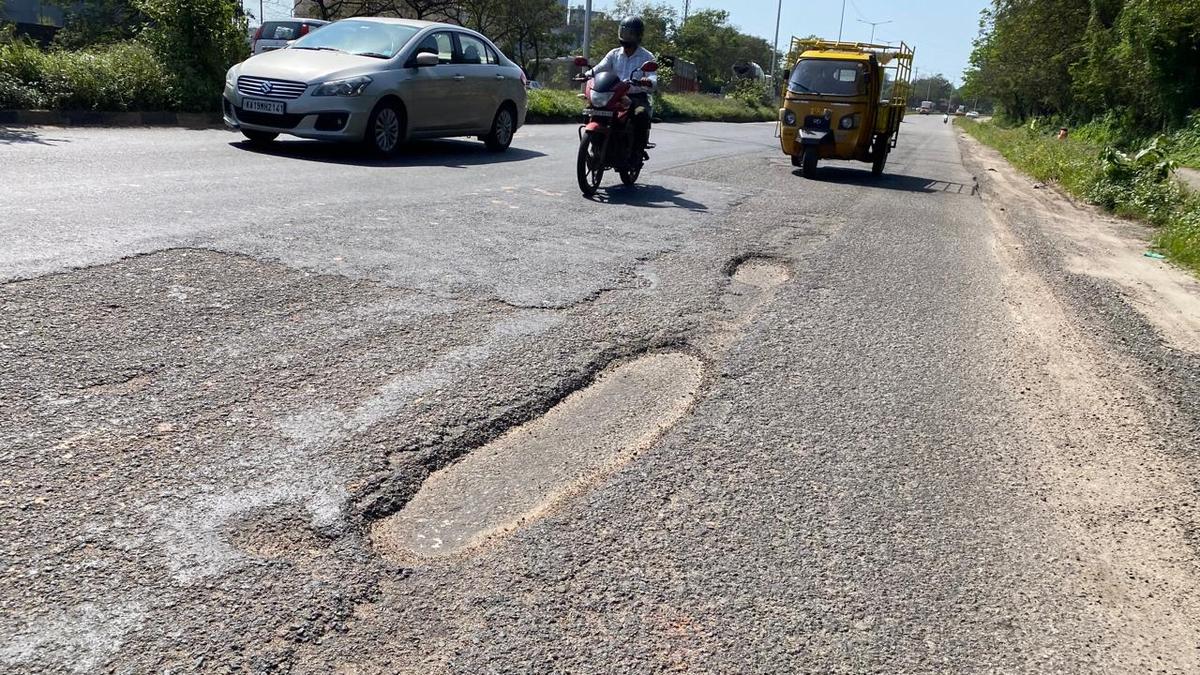Despite a brief respite from heavy rains, the Baikampady-Nanthoor stretch of National Highway 66 continues to be riddled with potholes and craters, leaving commuters frustrated and fearful. The battered road has become a daily nightmare for motorists, with two-wheelers, in particular, facing the highest risk of accidents. Local residents argue that repeated complaints to authorities have not translated into meaningful action. They point out that temporary patchwork repairs wash away within days, leaving the surface worse than before. The persistence of these potholes has reignited debates about accountability in infrastructure maintenance.
For Mangaluru’s residents, the NH 66 stretch is not just a commuter route but a vital economic lifeline. The road is heavily used by transport trucks, buses, and private vehicles connecting key industrial and commercial hubs. Frequent breakdowns and traffic jams caused by the cratered road have increased fuel consumption and repair costs for vehicle owners. Traders warn that delays in transporting goods are affecting supply chains and eating into profits. Residents argue that the authorities’ failure to provide a durable solution reflects systemic neglect, where funds are announced but proper quality checks and follow-up remain absent.
Road safety experts caution that the deteriorating condition of NH 66 could lead to more fatal accidents if not addressed urgently. They note that while rains have slowed, authorities must seize this window to implement permanent resurfacing with quality materials, rather than resorting to cosmetic fixes. They argue that accountability must extend beyond contractors to include supervisory engineers and officials who pass substandard work. Without strong deterrents against negligence, experts fear that road users will continue to suffer every monsoon. For many, the NH 66 debacle symbolizes the poor state of infrastructure governance in the region.

Authorities Struggle to Justify Delays in Repairs
Highway authorities have attributed the poor condition of the Baikampady-Nanthoor stretch to heavy monsoon rains and increased traffic load from container trucks servicing nearby ports and industries. Officials claim that repair work is underway but admit that waterlogging and drainage issues have slowed progress. However, residents argue that these explanations have become repetitive excuses heard every year during the monsoon season. Civic groups demand stronger accountability mechanisms, including blacklisting contractors who deliver poor work and setting strict deadlines for repairs. They believe that only such systemic reforms can prevent the cycle of neglect.
Meanwhile, political representatives from the region have stepped in, promising to escalate the issue to both state and central authorities. Opposition leaders accuse the ruling government of ignoring coastal Karnataka’s infrastructure needs, while ruling party members argue that long-term projects for road widening and concrete resurfacing are already in the pipeline. For commuters, however, these assurances ring hollow as they continue to endure the pothole-ridden stretch every day. Social media has amplified their voices, with videos and photos of the highway’s condition going viral, putting additional pressure on officials to act swiftly and decisively.
The Road Ahead for NH 66 Users
Looking forward, experts emphasize that what NH 66 requires is not patchwork but a comprehensive overhaul, including redesigning drainage systems, resurfacing with high-grade materials, and ensuring constant monitoring. Commuters insist that a durable solution must be implemented before the next monsoon season to prevent a repeat crisis. Until then, many fear that lives remain at risk each day as vehicles navigate dangerously uneven terrain. The Baikampady-Nanthoor stretch stands as both a physical and symbolic reminder of how inadequate planning and poor accountability in road maintenance can erode public trust in governance.
The condition of the Baikampady-Nanthoor stretch has also raised questions about the broader state of road infrastructure across Karnataka. Civic activists argue that while highways are meant to be maintained by central authorities through agencies like the National Highways Authority of India (NHAI), coordination with local bodies often breaks down. This results in prolonged delays and buck-passing between state, central, and municipal authorities. For commuters, the technicalities of jurisdiction matter little; what they seek is safe and functional roads. The failure to fix NH 66 has, therefore, become a symbol of bureaucratic inefficiency.
Truck drivers, who rely heavily on this highway to transport goods between the Mangaluru port and the hinterland, have been among the most vocal critics of the road’s condition. They complain of constant wear and tear on their vehicles, including frequent punctures, axle damage, and brake failures caused by navigating deep craters. Many note that accidents have occurred at night when visibility is low, with unsuspecting drivers being caught off guard. For them, the potholes are not just an inconvenience but a direct economic burden and a safety hazard that threatens livelihoods.
The tourism industry has also felt the impact of NH 66’s condition. With Mangaluru and nearby coastal stretches attracting visitors, smooth connectivity is essential for promoting the region. Tour operators say tourists often complain about bumpy rides and wasted time stuck in traffic caused by damaged stretches. Some even choose alternative routes, bypassing Mangaluru altogether, which hurts the local economy. For an area heavily dependent on both port trade and tourism, the state of this stretch has far-reaching consequences that go beyond daily commuters.

Public anger over the road condition has translated into civic protests and demonstrations. Several residents’ welfare groups have staged sit-ins and symbolic roadblocks to draw attention to the issue. Petitions have also been submitted to the district administration and the NHAI, demanding immediate action. Protesters argue that while governments often spend lavishly on high-profile projects in Bengaluru, essential road networks in coastal districts are consistently neglected. These movements reflect a growing frustration with what locals perceive as uneven development priorities across Karnataka.
Financial transparency in roadworks has emerged as another key concern among activists and opposition leaders. They question how large sums allocated for road maintenance fail to translate into durable repairs. Allegations of corruption and poor monitoring have resurfaced, with calls for an independent audit of funds spent on NH 66. Critics insist that unless the process of awarding contracts and supervising execution becomes more transparent, even repeated repairs will not solve the problem. For them, the Baikampady-Nanthoor stretch is evidence of systemic flaws in the infrastructure funding process.
The presence of waterlogging along the highway has further compounded the crisis. Experts argue that improper drainage design has allowed rainwater to accumulate, weakening the road surface and accelerating the formation of potholes. They emphasize that without structural improvements in drainage, resurfacing alone will not provide long-term relief. This technical lapse has become a recurring feature of NH 66 and other highways in the state, where short-term fixes repeatedly fail. Engineers and civic planners now argue for integrated designs that combine road maintenance with effective stormwater management.
Comparisons have also been drawn with national highways in other states that have been successfully upgraded and maintained to higher standards. Commuters point to stretches in Kerala and Maharashtra where concrete roads and rigorous monitoring have produced smoother travel experiences. They question why Karnataka has lagged behind despite having similar allocations. The contrast has fueled resentment among residents who feel that their region is being sidelined in terms of infrastructure priorities. This sense of relative neglect has become part of the political discourse surrounding NH 66.
Social media has amplified the issue by making the condition of NH 66 visible beyond Mangaluru. Viral videos showing vehicles stuck or damaged on the pothole-ridden stretch have drawn widespread outrage. Memes and sarcastic posts have criticized the government, with some comparing the road to a lunar landscape. While humor has provided an outlet for public frustration, it has also intensified the pressure on authorities. In today’s digital age, such visibility ensures that local issues can no longer remain confined to district boundaries, adding political weight to demands for action.

Legal recourse has also been considered by some citizen groups, who are contemplating filing public interest litigations (PILs) in court to compel timely repairs. Past cases in other parts of Karnataka have seen courts step in to direct accountability, and activists believe similar intervention may be necessary here. If pursued, such legal action could put additional pressure on both state agencies and the NHAI to deliver durable solutions. However, critics caution that litigation is time-consuming, and the immediate urgency of road safety requires faster administrative action rather than prolonged legal battles.
Ultimately, the pothole crisis on the Baikampady-Nanthoor stretch reflects a larger question of governance priorities in Karnataka. Residents argue that while urban centers like Bengaluru receive disproportionate attention, coastal Karnataka continues to struggle with basic infrastructure. This imbalance fuels discontent, as locals feel neglected despite contributing significantly to the state’s economy through trade, industry, and tourism. Unless authorities act decisively, the NH 66 debacle risks becoming a lasting symbol of neglect and inefficiency, deepening the trust deficit between citizens and those tasked with ensuring safe roads.
Follow: Karnataka Government
Also read: Home | Channel 6 Network – Latest News, Breaking Updates: Politics, Business, Tech & More

